New Problems Hit T-45; Navy Tightens Flight Limits
Posted on
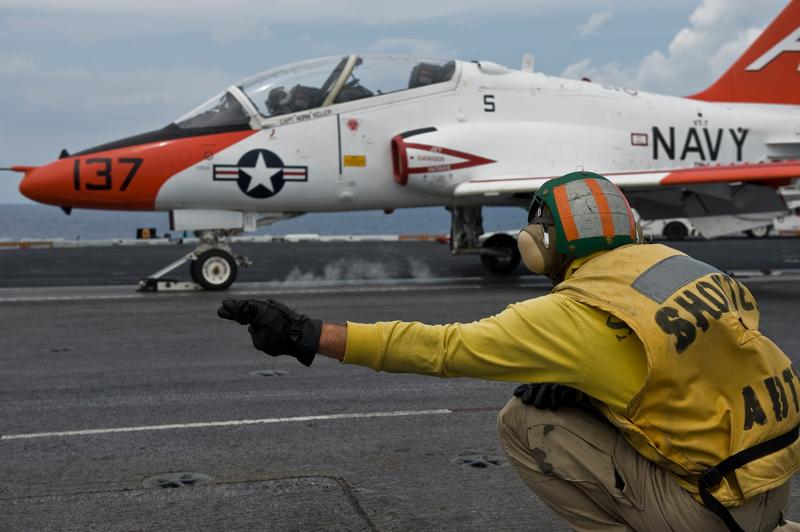
Navy T-45 Goshawk trainers can’t operate off carriers, like this one here, until the restrictions are lifted.
Days after the Navy’s T-45 Goshawk trainers returned to flight under strict safety restrictions because of problems with their air supply, the service felt compelled to make them even stricter.
An aircrew’s report of “minor headaches” prompted the tighter limits, a Navy spokesperson told Breaking Defense.
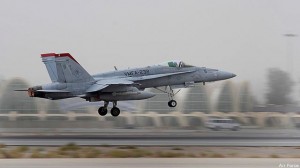
F-18s are also experiencing problems with their air supply.
Only one flight out of 92 over 48 hours reported such a problem, and Navy doctors ultimately decided the two experienced instructor-pilots’ “discomfort” was just a normal side-effect of stressful fighter maneuvers. It does not seem to be a new problem with the air supply, the issue that led T-45 instructors to refuse to fly in March. But with “Physiological Episodes” from headaches to disorientation increasingly afflicting not just T-45 crews but F-18 fighter pilots as well, the admirals clearly would rather err on the side of caution.
How cautious? T-45s are jet trainers capable of high-gee combat maneuvers at over 42,000 feet. Pilots returned to flight Tuesday under orders to stay below 4 Gs and 10,000 feet, avoiding thin high-altitude air that would require turning on the suspect On Board Oxygen Generation System (OBOGS). After this week’s flights, with OBOGS off, the new limit is just 2 Gs and 5,000 feet — less than 12 percent of the plane’s maximum performance. Carrier operations are suspended. And while the whole point of having T-45s is to train new pilots, students aren’t flying at all: For now, only experienced instructors are.
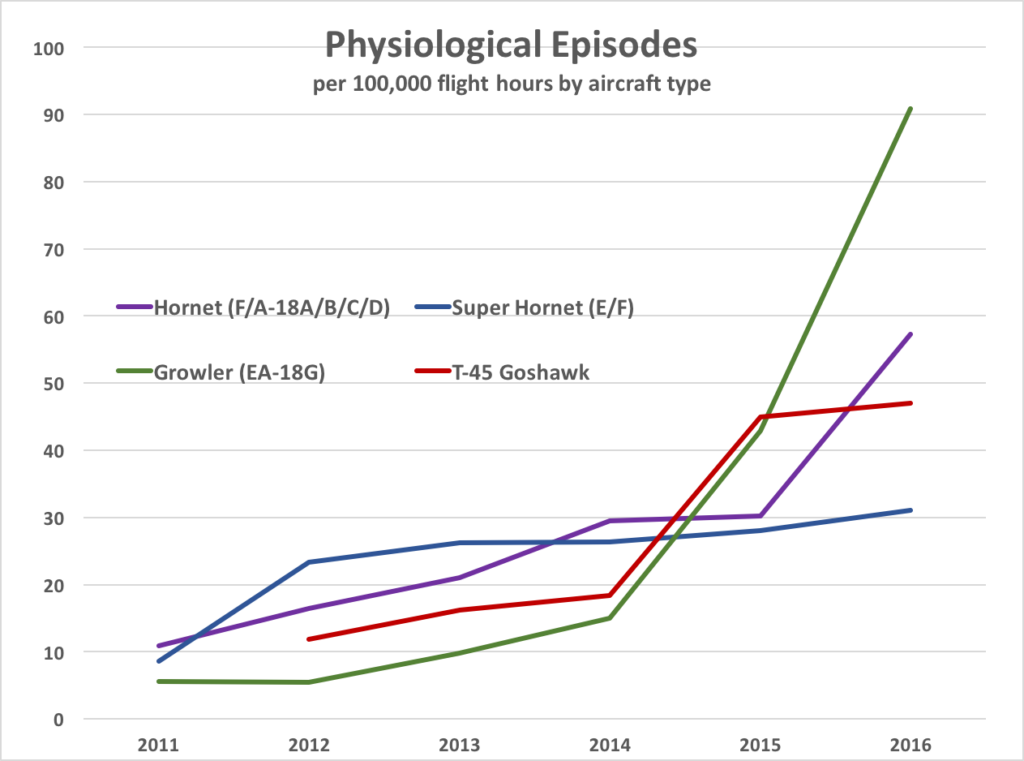
“Physiological episodes” caused by problems with air supply have risen dramatically for both the Navy’s T-45 Goshawk trainers and all variants of its F-18 Hornet strike fighters. (Navy data)
Safety Dance
“It’s all about safety,” Naval Air Forces spokeswoman Cdr. Jeannie Groeneveld says. “We’re taking a very measured approach to getting back into this. That’s why we sent these very experienced instructor pilots up.” When the two pilots came down reporting headaches, they were interviewed by a team of flight surgeons, toxicologists, and other aeromedical experts. Yesterday morning, Navy leaders held a “Physiological Episode Summit” to go over feedback from all the pilots flying.
In particular, those pilots are checking out a modified version of the helmet mask, which doesn’t pipe in air from the OBOGS. Instead, the pilot breathes the ambient air in the cockpit, hence the restriction to lower altitudes where the air is thick enough to breathe. (The Navy decided against getting rid of the mask altogether because it contains the radio microphone and helps hold the helmet on safely during ejection).
It’s a painstaking process of eliminating variables. “We’re taking that OBOGS system out of the equation,” Groeneveld told me yesterday evening. Whatever gave these two T-45 instructors their headaches, OBOGS wasn’t it.
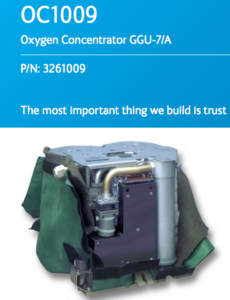
Cobham Oxygen Concentrator used on T-45s
There is no smoking gun, source after source told me, from the Navy to industry to Capitol Hill. When I first investigated the air supply problems on both the T-45 and F-18, the On-Board Oxygen Generation System looked like the obvious link. Pilots definitely need oxygen, and contractor Cobham makes the OBOGS for both the T-45 and the F-18. The problem with this theory is that Cobham makes the OBOGS for lots of other aircraft, from various models of the H-60 helicopter to the four-engine C-130 transport, the F-15 fighter, the F-16 and A-10, and the V-22 tiltrotor, and they aren’t having problems. In fact, the key part on the T-45, the oxygen concentrator, is the exact same model number (OC1009) as the one on the Marine Corps AV-8B Harrier, and while the Harriers are aging and problem-plagued in general, Naval Air Systems Command (NAVAIR) confirmed they aren’t having issues with their air supply. The F-18 OBOGS is slightly different but derived from the Harrier’s.
When you look closely at the F-18, the problem gets even more confusing. There are multiple models, not all of which even have an OBOGS, but all of which have had air problems, from pilot hypoxia to canopies literally exploding from too much air pressure. (T-45s, thankfully, have not had this overpressure issue).
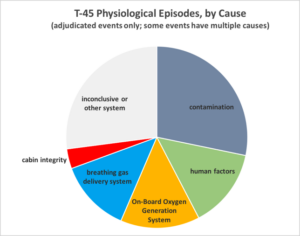
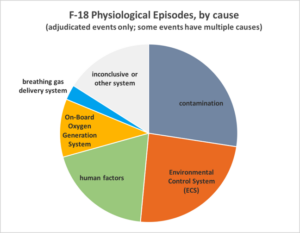 Many older “Legacy Hornet” aircraft, the F-18A, B, C, & D models, still use old-school bottles of liquid oxygen. LOX bottles take up a lot of weight, they only last a limited time, and they have a nasty tendency to explode when hit by enemy fire. That’s why the military moved to On-Board Oxygen Generation Systems. OBOGS don’t really “generate” oxygen but rather skim air off the engine intake — an unlimited supply as long as the aircraft keeps flying — then purify, cool, and concentrate it for the aircrew to breathe.
Many older “Legacy Hornet” aircraft, the F-18A, B, C, & D models, still use old-school bottles of liquid oxygen. LOX bottles take up a lot of weight, they only last a limited time, and they have a nasty tendency to explode when hit by enemy fire. That’s why the military moved to On-Board Oxygen Generation Systems. OBOGS don’t really “generate” oxygen but rather skim air off the engine intake — an unlimited supply as long as the aircraft keeps flying — then purify, cool, and concentrate it for the aircrew to breathe.
OBOGS is a proven technology, with a 30-year track record, but it is inherently more complicated than LOX. Most aircraft with OBOGS carry a backup bottle of LOX just in case the oxygen generator has a problem. On Air Force planes, a Backup Oxygen System (BOS) even goes on automatically, something Navy planes lack.
One possibility is that the air is getting contaminated somewhere as it’s piped through the plane from the engine — which produces plenty of noxious gases — to the pilot. Air contamination (histoxic hypoxia) produces very similar symptoms to oxygen deprivation (hypoxic hypoxia), because both deprive the body of breathable air. The telltale difference is that oxygen deprivation symptoms go away quickly when you breathe pure oxygen, while contamination symptoms persist.
F-18 pilots consistently feel better after going on emergency oxygen, but T-45 pilots often continue to feel impaired and unwell even after cracking open their emergency LOX. That’s a troubling sign that contamination is a big part of the problem. The two pilots who had the headaches this week, however, felt better quickly as soon as they descended into denser air, Groeneveld said, which probably means they weren’t breathing in contaminants.

Navy Super Hornets deploy flares over Afghanistan.
No Smoking Gun
Are these disparate incidents symptoms of some fundamental problem across the force? One factor is that the average age of military hardware is going up across the board, leading to widespread reliability problems, especially in the Navy fighter fleet. Systems bought during the Reagan build-up are staying in service longer than they were designed to last, with replacements cancelled or delayed during the 1990s drawdown and the post-9/11 focus on Afghanistan, Iraq, and counterterrorism.
The average age of the T-45 fleet is 17 years, NAVAIR told me. The original T-45A models were built in the late 1980s and early 1990s, and 69 of those are still in service, albeit upgraded to current T-45C standard with better cockpit electronics. But most of the fleet, 130 aircraft, are newer planes built as Cs from the ground up, the last of them delivered as recently as 2009. That means T-45s vary widely in age, from eight years to 20-plus, but no one I’ve talked to mentioned any correlation that suggests older aircraft are having more problems with their air supply.
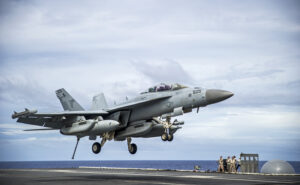
A Navy EA-18G Growler lands on the USS George Washington.
In fact, with the Hornet fleet, some of the newest aircraft are having the worst air problems: the EA-18G Growler radar-jamming variant, which is still in production. The slightly older Super Hornets (F/A-18E and F) are also having issues, not just the aging “legacy” Hornets (F/A-18A, B, C, & D) built during the 1980s. The older Hornets seem to have fewer problems with OBOGS — some don’t even have it installed — and more with other aspects of their Environmental Control System (ECS), but some Super Hornets have ECS issues as well.
Naval Air Systems Command and Boeing are systematically dismantling (by one count) an F-18C, two Super Hornets, and an EA-18G trying to find the root cause. Now NAVAIR is also taking apart three T-45s — one aircraft with reported problems from each training base — at their test site on the Patuxent River in Maryland.
Meanwhile, the instructor-pilots keep flying, but unlike the engineers, their reports are inherently subjective, because the Navy doesn’t have medical sensors for them to wear. In fact, whatever’s going wrong in the T-45, the cockpit warning light that’s supposed to alert the crew to air problems doesn’t even go on every time. (In F-18s, this light works consistently). Some pilots are being sent up with so-called sorbent tubes to test air quality in the cockpit, but the number of tubes is so limited, and the problems are so rare, that so far no one who had trouble breathing happened to have a sorbent tube handy.
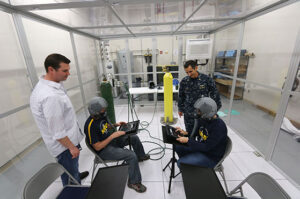
A Navy hypoxia research lab, the Reduced Oxygen Breathing Environment (ROBE)
As a result, there’s a shortage of hard data and a lot of subjective assessments. That’s a problem because, while the end-state symptoms of hypoxia are pretty obvious — you turn blue and pass out, then die — the symptoms of onset are the same as g-force stress, fatigue, low blood sugar, or even anxiety (say, anxiety about hypoxia): headaches, impaired judgment, general discomfort.
“It’s not something like a red flashing light comes on in the cockpit. It’s more like, ‘I’m not feeling quite right. I don’t know if it’s just because I’m tired or there’s something in the air,” one Hill staffer told me. And after years of under-reporting physiological episodes because they feared being grounded, pilots may now be over-reporting: “A few years ago they said, if you feel even the slightest weirdness, report it and count it.”
“Pilots are far more sensitized to these physiological episodes, not only in the T-45 but in naval aviation as a whole, than we ever were when I flew,” agreed one retired aviator. That said, all sources agreed, there is a real, physical problem, even if subjective reporting makes it harder to quantify, and it keeps on getting worse.

Congressional Concern
Congress has held multiple hearings on the air supply problem, the 2017 defense policy bill demanded action, and several staffers went down to the T-45 training bases just this week to investigate further. While the staffers I spoke to all appreciated the complexity of the problem, more than one felt the Navy could have handled it better.
“What caught us a little bit by surprise (was) the fact that there were three training squadrons’ worth of instructors that thought this was such a serious issue that they all just decided not to fly one day,” said one House Armed Services Committee staffer. “It took a lot of balls for those guys and gals to do that. (That’s a) breakdown in the chain of command.”
That Navy pilots effectively went on strike shows “a big breakdown in communication between the engineers and the operators,” agreed a Senate staffer. While NAVAIR was working on the problem, the pilots apparently weren’t kept informed of that effort, nor were they being issued medical sensors to enable objective reporting, leading many to feel their concerns were being ignored. That’s part of why the admirals are being so solicitous and careful now.
In fact, the Navy is definitely working on the problem — they’re just not solving it. “The persistence of this problem… is a little bit unusual,” said one Hill staffer. With past problems, “they’ve been relatively quick to find a smoking gun and then they ground the fleet, replace that part, and get everybody back airborne.” This time, he said, “the Navy has their best people on this, and if there was a smoking gun, they’d have figured it out back in 2010. So far they haven’t been able to.”
Are they really the Navy’s best people, though? “They’ve had this Physiological Episodes Team set up in NAVAIR since 2010 … saying it’s naval aviation’s No. 1 safety issue for a few years now at least,” said a second staffer. “You have to question, do we have the A-Team and do they have the resources they need?”
Here’s the full statement Cdr. Jeannie Groeneveld of Naval Air Forces gave us last night:
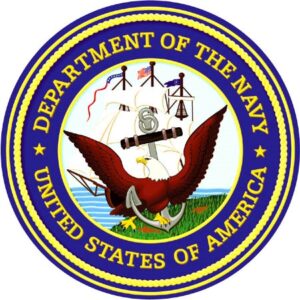 T-45C flights resumed on Tuesday, with only our most experienced instructor pilots flying, after being briefed on updated mitigations and operating procedures. Our primary goal is to learn how our pilots adapt to the new mask configuration and to identify potential concerns. Since resuming flight operations we have had one crew report minor post-flight symptoms (this was one flight out of 92 flown over the two days). During their flight, the two instructors flew to the maximum altitude allowed with the new mask (10,000 feet cabin altitude) and conducted dynamic flight maneuvers, surpassing 4 Gs, to better understand the limitations of the new procedures.
T-45C flights resumed on Tuesday, with only our most experienced instructor pilots flying, after being briefed on updated mitigations and operating procedures. Our primary goal is to learn how our pilots adapt to the new mask configuration and to identify potential concerns. Since resuming flight operations we have had one crew report minor post-flight symptoms (this was one flight out of 92 flown over the two days). During their flight, the two instructors flew to the maximum altitude allowed with the new mask (10,000 feet cabin altitude) and conducted dynamic flight maneuvers, surpassing 4 Gs, to better understand the limitations of the new procedures.
Our aeromedical crisis action team interviewed the pilots to understand exactly what they experienced and what may have caused their symptoms (minor headaches). After the in-depth interview and given that the aircrew’s symptoms subsided as they descended, the medical team has assessed that the discomfort was due to increased activity — pulling G’s at altitude, similar to what one would experience when climbing or performing intense exercise at higher altitude. They have found no indications that the symptoms were induced by anything related to the plane or its systems (based on the fact the symptoms cleared when they descended to lower altitude), but as a precaution we sent a team of engineers to Kingsville to inspect the aircraft.
Based on feedback from the Instructor Pilots, we have implemented further precautionary measures, to include:
- Maximum flight altitude of 5,000 MSL, pilots are limited to less than 2Gs when flying.
- We are reevaluating the new mask configuration based on feedback aircrew conveyed after their flights.
Safety is our priority; we will ensure that all mitigations are implemented, required procedural changes identified and communicated with all our aviators.
Subscribe to our newsletter
Promotions, new products and sales. Directly to your inbox.
